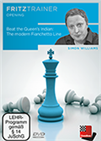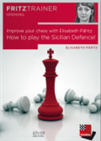An eventful round
Until round seven, Vidit's performance in Prague was close to perfect, showing strong preparation with White to score three wins and managing to keep things under control with Black, even when he got slightly inferior positions. In rounds seven and eight, he got his first back-to-back Whites and, by move 15 of his game against David Navara, it looked like the Indian was about to put an end to the fight for first in style:
 This DVD is packed full of new, exciting and novel ideas; based on a repertoire starting with the moves 1 d4 Nf6 2 c4 e6 3 Nf3 with g3! to follow.
This DVD is packed full of new, exciting and novel ideas; based on a repertoire starting with the moves 1 d4 Nf6 2 c4 e6 3 Nf3 with g3! to follow.
Out of a Queen's Indian Defence, Vidit quickly got a space advantage in the centre with 8.e4 and 9.e5, an idea that had not been seen in this exact position in the past. The Indian spent quite a while on his eighth and eleventh moves, as he carefully calculated whether the pawn breaks in both cases (8.e4 and 11.d5) were good for him. The position was difficult to assess correctly, and Navara gave his opponent a chance to sacrifice for a strong attack with 15.♗xf7 in the diagrammed position.
The game continued 15...♚xf7 16.e6+ (giving up the pawn) ♚xe6 17.♕e2+ ♚f7 18.0-0-0 ♝f6 19.♘e4+, when Black is a full piece up, although his king is in deep trouble!
Soon enough, Black gave back the piece to defend against the threats, entering a markedly uncomfortable endgame with four rooks and four knights still on the board. Allowing a rook swap was a strategical mistake by Vidit:
33.b3 permitted Black to release some tension with 33...♜xd7. Instead, 33.♖df7+ ♚e8 and now 34.b3 would have posed Black many more problems with the rooks still doubled on the seventh rank.
From this point on, Navara showed a lot of resourcefulness to turn the tables, giving up a pawn in exchange for activity. In a dynamically balanced position, Vidit faltered again by allowing his opponent to get two connected passers on the queenside:
White played the committal 55.c5, considering that after 55...b5 his passer on the c-file combined with a potential passer on the kingside would give him enough counterplay. It was a miscalculation, as Black had enough time to advance his pawns, cover the g-file with his rook and defend the c-file with his king. Nine moves later, Vidit resigned. It was certainly a painful defeat for the 25-year-old from Nashik.

Vidit and David Navara in the background | Photo: Petr Vrabec
With one round to go, three players are now a half point behind Vidit, who will have the tough task of facing Jan-Krzysztof Duda with Black in a deciding match-up. One of the chasers is David Anton, who defeated tail-ender Nils Grandelius with the black pieces on Thursday. Anton was in his element, dealing with a close-to-static pawn structure. The Spaniard got to take advantage of White's vulnerable kingside — at some point, he positionally sacrificed a knight to improve his chances:
 The continuous stream of new ideas in the Sicilian makes 1..c5 the most popular answer to 1.e4. On this DVD I do give an introduction to the most important Sicilian systems.
The continuous stream of new ideas in the Sicilian makes 1..c5 the most popular answer to 1.e4. On this DVD I do give an introduction to the most important Sicilian systems.
Black destroyed his rival's strong pawn centre with 23...♞xe5, getting to push on the kingside in the sequence 24.dxe5 ♛xe5 25.♗d2 h6 26.♘h3 e6 27.♖e1 ♛f6 28.♘f2 h5. Anton had four pawns for the piece and a much more comfortable position to boot. From this point on, the winner of last year's Challengers showed great technique to convert his advantage into a full point. Grandelius defended tenaciously, but eventually accepted defeat on move 67.

The playing hall and the 'control centre' | Photo: Vladimir Jagr
Vitiugov, in the meantime, missed a chance to catch up with the leader, as he could not make the most of his considerable edge with White against Duda.
 Despite the fact that many books have been written on tactics in chess, many players still find it extremely difficult to recognise tactical patterns and calculate ensuing lines. With this disk the author not only gives a large number of examples of the most different kind, trying to cover as many ideas as possible, but also suggests a method which will greatly help you to see various tactical motives and systemise your calculation.
Despite the fact that many books have been written on tactics in chess, many players still find it extremely difficult to recognise tactical patterns and calculate ensuing lines. With this disk the author not only gives a large number of examples of the most different kind, trying to cover as many ideas as possible, but also suggests a method which will greatly help you to see various tactical motives and systemise your calculation.
Duda had started losing the thread on move 30, and with his previous 34...♜b4 he had given his opponent a chance to pretty much put an end to the game with 35.♘d6, piling up against f7 — in case of 35...♜d4, White has 36.♖e7 threatening mate with the rook on e8, to which Black can only respond with 36...♛c6 37.♖e8+ ♛xe8 38.♘xe8, giving up the queen. Instead, Vitiugov played 35.f3, when White is still in the driver's seat but has a tougher task in conversion.
Nevertheless, Black still needed to give up his queen to defend against the attack, except that he made the sacrifice in more favourable circumstances. Eventually, the players entered an endgame with queen and pawn against rook and two pawns, leaving White with a tough technical task to win the game. Duda defended resourcefully and built an impenetrable fortress by move 60. Vitiugov kept on trying for a while, but eventually acquiesced to the draw.

Defending champion Nikita Vitiugov during round five | Photo: Petr Vrabec
In the shortest game of the day, Harikrishna and Markus Ragger signed a 35-move draw out of a Ruy Lopez, while Alireza Firouzja got to put pressure against Sam Shankland from the white side of an Italian but could not escape the drawish nature of rook endgames. The 16-year-old will play Black against Anton in the final round, while Shankland will have the white pieces against Vitiugov. Friday's last day of action kicks off an hour earlier than usual, at 13:00 UTC (14:00 CET / 8:00 AM EST).
Standings after Round 8
Replay all games
Links


























